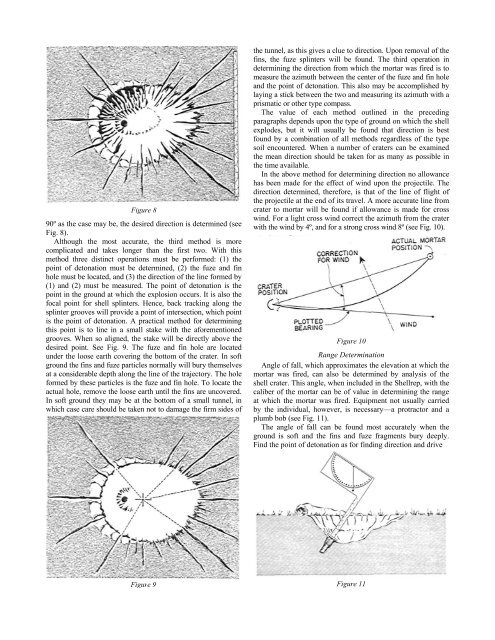the field artillery journal - Fort Sill - U.S. Army
the field artillery journal - Fort Sill - U.S. Army
the field artillery journal - Fort Sill - U.S. Army
You also want an ePaper? Increase the reach of your titles
YUMPU automatically turns print PDFs into web optimized ePapers that Google loves.
Figure 8<br />
90º as <strong>the</strong> case may be, <strong>the</strong> desired direction is determined (see<br />
Fig. 8).<br />
Although <strong>the</strong> most accurate, <strong>the</strong> third method is more<br />
complicated and takes longer than <strong>the</strong> first two. With this<br />
method three distinct operations must be performed: (1) <strong>the</strong><br />
point of detonation must be determined, (2) <strong>the</strong> fuze and fin<br />
hole must be located, and (3) <strong>the</strong> direction of <strong>the</strong> line formed by<br />
(1) and (2) must be measured. The point of detonation is <strong>the</strong><br />
point in <strong>the</strong> ground at which <strong>the</strong> explosion occurs. It is also <strong>the</strong><br />
focal point for shell splinters. Hence, back tracking along <strong>the</strong><br />
splinter grooves will provide a point of intersection, which point<br />
is <strong>the</strong> point of detonation. A practical method for determining<br />
this point is to line in a small stake with <strong>the</strong> aforementioned<br />
grooves. When so aligned, <strong>the</strong> stake will be directly above <strong>the</strong><br />
desired point. See Fig. 9. The fuze and fin hole are located<br />
under <strong>the</strong> loose earth covering <strong>the</strong> bottom of <strong>the</strong> crater. In soft<br />
ground<br />
<strong>the</strong> fins and fuze particles normally will bury <strong>the</strong>mselves<br />
at a considerable depth along <strong>the</strong> line of <strong>the</strong> trajectory. The hole<br />
formed by <strong>the</strong>se particles is <strong>the</strong> fuze and fin hole. To locate <strong>the</strong><br />
actual hole, remove <strong>the</strong> loose earth until <strong>the</strong> fins are uncovered.<br />
In soft ground <strong>the</strong>y may be at <strong>the</strong> bottom of a small tunnel, in<br />
which case care should be taken not to damage <strong>the</strong> firm sides of<br />
Figure 9<br />
<strong>the</strong> tunnel, as this gives a clue to direction. Upon removal of <strong>the</strong><br />
fins, <strong>the</strong> fuze splinters will be found. The third operation in<br />
determining <strong>the</strong> direction from which <strong>the</strong> mortar was fired is to<br />
measure <strong>the</strong> azimuth between <strong>the</strong> center of <strong>the</strong> fuze and fin hole<br />
and <strong>the</strong> point of detonation. This also may be accomplished by<br />
laying a stick between <strong>the</strong> two and measuring its azimuth with a<br />
prismatic or o<strong>the</strong>r type compass.<br />
The value of each method outlined in <strong>the</strong> preceding<br />
paragraphs depends upon <strong>the</strong> type of ground on which <strong>the</strong> shell<br />
explodes, but it will usually be found that direction is best<br />
found by a combination of all methods regardless of <strong>the</strong> type<br />
soil encountered. When a number of craters can be examined<br />
<strong>the</strong> mean direction should be taken for as many as possible in<br />
<strong>the</strong> time available.<br />
In <strong>the</strong> above method for determining direction no allowance<br />
has been made for <strong>the</strong> effect of wind upon <strong>the</strong> projectile. The<br />
direction determined, <strong>the</strong>refore, is that of <strong>the</strong> line of flight of<br />
<strong>the</strong> projectile at <strong>the</strong> end of its travel. A more accurate line from<br />
crater to mortar will be found if allowance is made for cross<br />
wind. For a light cross wind correct <strong>the</strong> azimuth from <strong>the</strong> crater<br />
with <strong>the</strong> wind by 4º, and for a strong cross wind 8º (see Fig. 10).<br />
Figure 10<br />
Range Determination<br />
Angle of fall, which approximates <strong>the</strong> elevation at which <strong>the</strong><br />
mortar was fired, can also be determined by analysis of <strong>the</strong><br />
shell crater. This angle, when included in <strong>the</strong> Shellrep, with <strong>the</strong><br />
caliber of <strong>the</strong> mortar can be of value in determining <strong>the</strong> range<br />
at which <strong>the</strong> mortar was fired. Equipment not usually carried<br />
by <strong>the</strong> individual, however, is necessary—a protractor and a<br />
plumb bob (see Fig. 11).<br />
The angle of fall can be found most accurately when <strong>the</strong><br />
ground is soft and <strong>the</strong> fins and fuze fragments bury deeply.<br />
Find <strong>the</strong> point of detonation as for finding direction and drive<br />
Figure 11

















